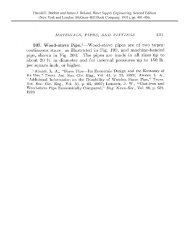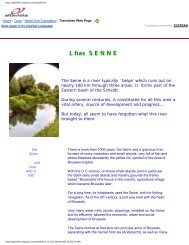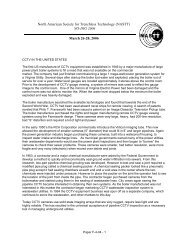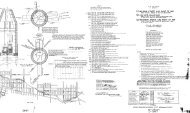The Water Supply and Distribution System of the Nabataean City of ...
The Water Supply and Distribution System of the Nabataean City of ...
The Water Supply and Distribution System of the Nabataean City of ...
Create successful ePaper yourself
Turn your PDF publications into a flip-book with our unique Google optimized e-Paper software.
Figure 10. Typical rippled wall pattern within <strong>the</strong><br />
interior <strong>of</strong> <strong>Nabataean</strong> piping.<br />
translate proportionately into flow rate increases (Ortl<strong>of</strong>f<br />
& Crouch 2001). For this reason, long pipelines,<br />
where feasible, are usually interrupted by open basins<br />
placed along <strong>the</strong>ir length, effectively to create short<br />
piping segments between (cleanable) head basins. Such<br />
a system permits higher flow rates than a continuous<br />
pipeline with no intermediate basins. Although this<br />
practice is observed in Roman piping networks (Ortl<strong>of</strong>f<br />
& Crouch 2001), it is probably an innovation <strong>of</strong><br />
pre-Roman times. <strong>The</strong> piping on <strong>the</strong> north side <strong>of</strong> <strong>the</strong><br />
Siq provided <strong>the</strong> main potable water supply. <strong>The</strong> southside<br />
channel, on <strong>the</strong> o<strong>the</strong>r h<strong>and</strong>, was probably meant for<br />
animal watering purposes <strong>and</strong> may have been supplied<br />
by a channel from Ain Braq <strong>and</strong> supplemented from a<br />
cistern atop <strong>the</strong> bluffs with a drop hole to this channel<br />
(C0, Fig. 1). This may have fed <strong>the</strong> south-side systems<br />
in <strong>the</strong> <strong>the</strong>atre district but it is not possible to verify this<br />
connection at present.<br />
<strong>The</strong> Siq piping system — flow stability<br />
considerations<br />
<strong>Nabataean</strong> pipeline design solutions can best be illustrated<br />
by a computer analysis that reproduces internal<br />
flow details. To examine flow stability in <strong>the</strong> Siq northside<br />
piping, sample computer models were made <strong>of</strong><br />
a 1220-m-long section with 14.0-cm-diameter piping<br />
inclined at a 2.5 degree angle with <strong>and</strong> without internal<br />
roughness. <strong>The</strong> Ain Mousa spring had a high flow rate<br />
which <strong>the</strong> Siq piping system must have accommodated.<br />
A number <strong>of</strong> sample FLOW-3D computer runs (Flow<br />
Science Inc. 2003) were made for velocities <strong>of</strong> 0.305 (Fig.<br />
9a), 0.610 (Fig. 9b), 1.524 (Fig. 9c), 3.05 (Fig. 9e), 6.10 <strong>and</strong><br />
Charles R. Ortl<strong>of</strong>f<br />
106<br />
9.15 m/s using <strong>the</strong> measured slope <strong>and</strong> wall roughness.<br />
One criterion for determining an acceptable flow rate<br />
relies on flow stability (i.e. is flow smoothly delivered<br />
to a destination point without pulsations?). A second<br />
criterion asks if <strong>the</strong> flow delivered to an open basin can<br />
be successively transported to <strong>the</strong> next pipeline segment<br />
without spillage <strong>and</strong> if a stable free surface flow<br />
exists in <strong>the</strong> piping that can transfer water smoothly to<br />
sequential pipelines interrupted by intermediate basins<br />
without sloshing. For this to occur, pipeline segments<br />
between basins must have <strong>the</strong> same resistance characteristics,<br />
similar internal flow patterns <strong>and</strong> <strong>the</strong> same<br />
entry conditions. A third criterion requires that <strong>the</strong> flow<br />
rate is sufficiently high to accommodate urban-core water<br />
needs for a population <strong>of</strong> 30,000. A fur<strong>the</strong>r criterion<br />
is minimization <strong>of</strong> leakage. Here partial (internal open<br />
channel) flow is preferable as hydrostatic pressure effects<br />
causing leakage are reduced.<br />
<strong>The</strong> results indicate that flow velocities up to 1.52<br />
m/s (Figs. 9 a, b, c), with prescribed wall roughness as<br />
shown in Figures 5a <strong>and</strong> 10, produce an open channel<br />
flow within <strong>the</strong> piping but with an apparent unsteady<br />
delivery rate. This is manifested by r<strong>and</strong>om water<br />
peaks that translate down <strong>the</strong> piping leading to an<br />
unsteady delivery resulting in possible sloshing <strong>and</strong><br />
spillage in open basins along <strong>the</strong> length <strong>of</strong> <strong>the</strong> piping.<br />
For piping with a smooth interior at this flow rate a<br />
smooth delivery flow rate can be achieved (Fig. 9d),<br />
but at <strong>the</strong> expense <strong>of</strong> a longer pipeline segment exposed<br />
to hydrostatic pressure <strong>and</strong> increased leakage.<br />
At a higher 3.05 m/s flow velocity (Fig. 9e), effects <strong>of</strong><br />
<strong>the</strong> roughness-induced, r<strong>and</strong>omly-distributed water<br />
height changes disappear over much <strong>of</strong> <strong>the</strong> piping<br />
length leading to smooth free surface flow. This high<br />
speed flow turns back to a full flow after nearly 1200 m<br />
owing to cumulative wall friction effects (Fig. 9e). This<br />
negative feature can, however, easily be removed by<br />
<strong>the</strong> ‘head reset’ feature so that shorter length pipe segments<br />
connect open basins with open channel flows<br />
up to 400 m in length. This would require at least four<br />
north side basins within <strong>the</strong> Siq. Without open basins,<br />
an uninterrupted pipeline would contain an unsteady<br />
flow <strong>and</strong> require a large downstream settling basin<br />
to trap particles before fur<strong>the</strong>r distribution. <strong>The</strong> Siq<br />
excavator (Bellwald 2004, pers. comm.) has recently<br />
confirmed that <strong>the</strong>re are four open basins within <strong>the</strong><br />
Siq. <strong>The</strong>se would hence not only have provided drinking<br />
water for entrants to <strong>the</strong> city but also provided an<br />
elegant yet practical solution to <strong>the</strong> problem <strong>of</strong> flow<br />
stability. <strong>Water</strong> velocity <strong>of</strong> c. 3.0 m/s is adequate to<br />
prevent major instabilities <strong>and</strong> since <strong>the</strong> supercritical<br />
flow fills about 25 per cent <strong>of</strong> <strong>the</strong> piping cross-section<br />
(at normal depth) <strong>and</strong> allow a (very conservative) 50










